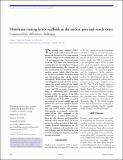Membrane-coating lattice scaffolds in the nuclear pore and vesicle coats: Commonalities, differences, challenges
Author(s)
Leksa, Nina Carolina; Schwartz, Thomas
DownloadSchwartz_Membrane-coating.pdf (1.247Mb)
PUBLISHER_CC
Publisher with Creative Commons License
Creative Commons Attribution
Terms of use
Metadata
Show full item recordAbstract
The nuclear pore complex (NPC) regulates all traffic between the cytoplasm and the nucleus. It is a large protein assembly composed of multiple copies of ~30 nucleoporins (nups). Structural studies of the NPC have been limited by its considerable size and complexity. Progress toward understanding the structure of this nanomachine has benefited from its modular nature, which allows for this 40-60 MDa assembly to be broken down into subcomplexes that can be studied individually. While recent work by both crystallographers and electron microscopists has greatly enhanced our model of the NPC, the resolution gap between crystal and EM structures remains too large to confidently place individual proteins within the context of the fully assembled NPC. In an effort to arrive at a veritable model of the NPC, we solved the structure of several scaffold nups and defined the ancestral coatomer element (ACE1) common to a set of nucleoporins and COPII vesicle coat proteins. Subsequently, we proposed a lattice-like model of the NPC, analogous to the COPII lattice, in which ACE1 proteins form the edge elements and β-propellers form the vertex elements. Here, we review our recent studies, speculate on how interactions between subcomplexes of the NPC are mediated, and outline the steps and challenges that lay ahead on the path to understanding this enormous assembly in molecular detail.
Date issued
2010-07Department
Massachusetts Institute of Technology. Department of BiologyJournal
Nucleus
Publisher
Landes Bioscience
Citation
Leksa, Nina C., and Thomas U. Schwartz. “Membrane-coating lattice scaffolds in the nuclear pore and vesicle coats: Commonalities, differences, challenges.” Nucleus 1, no. 4 (July 1, 2010): 314-318.
Version: Final published version
ISSN
1949-1034